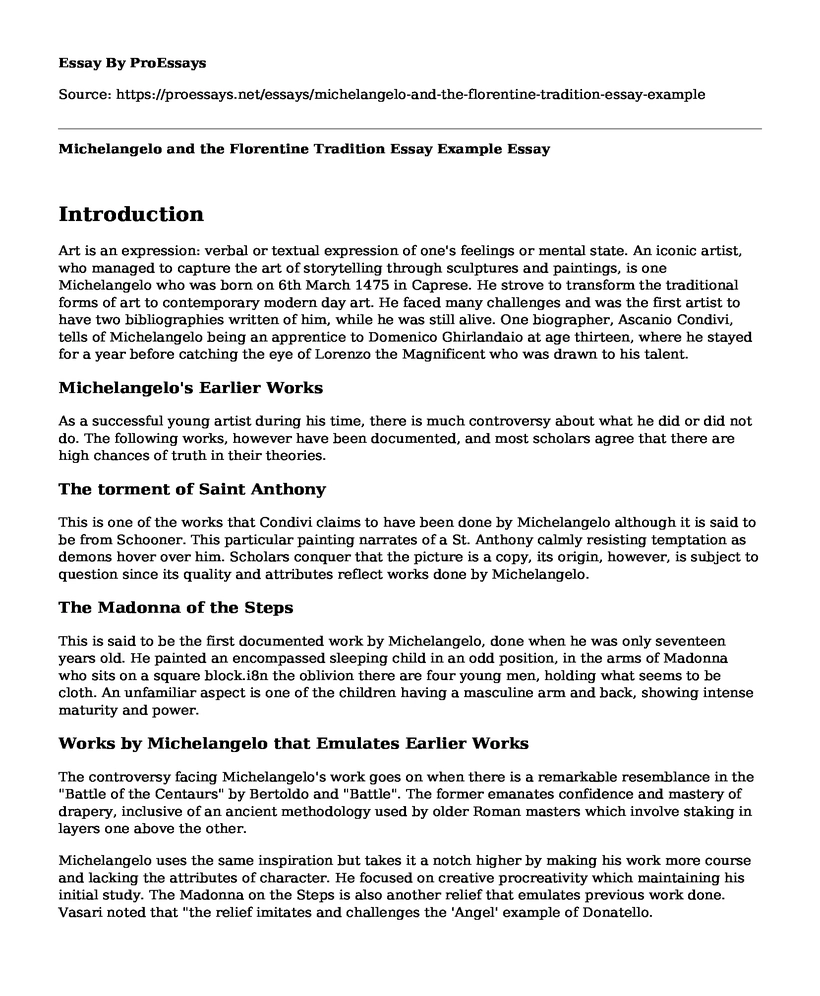Introduction
Art is an expression: verbal or textual expression of one's feelings or mental state. An iconic artist, who managed to capture the art of storytelling through sculptures and paintings, is one Michelangelo who was born on 6th March 1475 in Caprese. He strove to transform the traditional forms of art to contemporary modern day art. He faced many challenges and was the first artist to have two bibliographies written of him, while he was still alive. One biographer, Ascanio Condivi, tells of Michelangelo being an apprentice to Domenico Ghirlandaio at age thirteen, where he stayed for a year before catching the eye of Lorenzo the Magnificent who was drawn to his talent.
Michelangelo's Earlier Works
As a successful young artist during his time, there is much controversy about what he did or did not do. The following works, however have been documented, and most scholars agree that there are high chances of truth in their theories.
The torment of Saint Anthony
This is one of the works that Condivi claims to have been done by Michelangelo although it is said to be from Schooner. This particular painting narrates of a St. Anthony calmly resisting temptation as demons hover over him. Scholars conquer that the picture is a copy, its origin, however, is subject to question since its quality and attributes reflect works done by Michelangelo.
The Madonna of the Steps
This is said to be the first documented work by Michelangelo, done when he was only seventeen years old. He painted an encompassed sleeping child in an odd position, in the arms of Madonna who sits on a square block.i8n the oblivion there are four young men, holding what seems to be cloth. An unfamiliar aspect is one of the children having a masculine arm and back, showing intense maturity and power.
Works by Michelangelo that Emulates Earlier Works
The controversy facing Michelangelo's work goes on when there is a remarkable resemblance in the "Battle of the Centaurs" by Bertoldo and "Battle". The former emanates confidence and mastery of drapery, inclusive of an ancient methodology used by older Roman masters which involve staking in layers one above the other.
Michelangelo uses the same inspiration but takes it a notch higher by making his work more course and lacking the attributes of character. He focused on creative procreativity which maintaining his initial study. The Madonna on the Steps is also another relief that emulates previous work done. Vasari noted that "the relief imitates and challenges the 'Angel' example of Donatello.
Earlier Works Studied by Michelangelo
As mentioned earlier, Michelangelo was an apprentice to a highly successful Ghirlandaio hence joined the latter's academy where he studied his works. A case example that depicts that Michelangelo studied his master's work is the painting "the old man wearing a hat". This painting is similar to the "standing woman" by Ghirlandaio. It is however evident that despite these similarities, Michelangelo's painting overshadows the latter due to the solidity and precision that Ghirlandaio's painting did not carry.
Another instance is when Michelangelo painted two large frescos narrating a story of two saints, "Conversion of Saint Paul" and the "Crucifixion of Saint Peter". A similar fresco is one done by Ghirlandaio, during the time Michelangelo was his student. The "Sistine Chapel" told of scenes from the life of Saint John the Baptist and the Virgin", which took five years to complete.
Conclusion
Michelangelo's early work is a kaleidoscope of controversy with most of its authenticity being questionable. It is however factual that he was trained and honed his skills then became exceptional and legendary. Studies confirm him to be one of the most iconic and celebrated artists of all time, being a practitioner in his areas of expertise which included poetry, art and architecture. He drew his inspiration from his masters and consulted a wide variety of experts during his travels, as his aim and focus was for his works to be a creative paraphrase of previous works.
Bibliography
Dervin, Daniel. "The Humanist Child Peers Out from Renaissance Madonnas." In The Digital Child, pp. 144-158. Routledge, 2017.
Dillon, Anne. Michelangelo and the English martyrs. Routledge, 2016.
Smithers, Tamara. Michelangelo in the New Millennium: Conversations about Artistic Practice, Patronage and Christianity. Brill, 2016.
Gavitt, Philip. "Nicholas Scott Baker. The Fruit of Liberty: Political Culture in the Florentine Renaissance, 1480-1550." (2015): 731-732.
Paoletti, John T. Michelangelo's David: Florentine history and civic identity. Cambridge University Press, 2015.
Smith, Graham. A Medici Source for Michelangelo's Doni Tondo. Deutscher Kunstverlag, 1975.
Cite this page
Michelangelo and the Florentine Tradition Essay Example. (2022, Oct 23). Retrieved from https://proessays.net/essays/michelangelo-and-the-florentine-tradition-essay-example
If you are the original author of this essay and no longer wish to have it published on the ProEssays website, please click below to request its removal:
- Social Media's Effects on Decreasing Communication Skills
- Psychology Essay: Using Piaget's Cognitive Development Theory in the I Am Sam Movie
- Graffiti Writing: This Is Modern Art Play Essay
- Encounter With the Shadow Creative Writing
- Smartphone and Social Media Use in Healthcare Paper Example
- Anxiety and Social Media Essay Example
- Essay Sample on Banksy: The Mysterious Street Artist Who Fights for Social Justice







